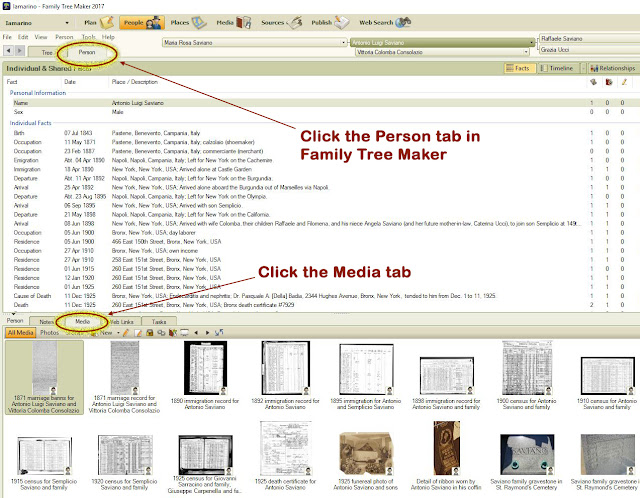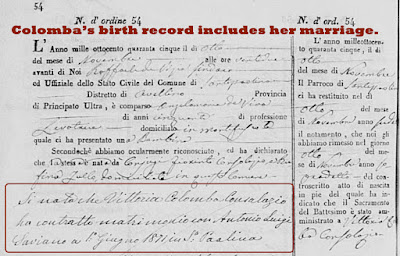Here's how I'm finding the missing connections for my newly discovered ancestor.
Recently I told you how I found a big error in my family tree. It was the result of hard-to-read documents and my not being familiar with a particular town's families. I wound up following Rubina Cenzullo when I should have been looking for Ruffina Zullo.
 |
| Some of my ancestors moved to nearby towns to marry. |
When her death record showed me the truth—that Ruffina was born in another town—I knew exactly what I had to do.
The most important documents I needed to find in the new town (Apice, Italy) were:
- her birth record (around 1816)
- her marriage to my 3rd great grandfather (around 1843)
But now I have a new family named Zullo, and a whole new branch to discover. Ruffina's parents were Leonardo and Caterina. But I want to learn the names of my 4th and 5th great grandparents in this branch.
Here's what I'm doing to expand my new Zullo branch.
Find Siblings, Marriages, Deaths
Ruffina was born in 1816 when her father was about 27 years old. There could be siblings born before Ruffina, for sure. To find them, I used the GetLinks program to download all the Apice birth records. (Read about how GetLinks works with FamilySearch and the Antenati website. You'll find the download link there, too.)
I downloaded her town's 1809–1815 birth records and looked for Ruffina's siblings. I found:
- Saverio Antonio Nicola Zullo, born in 1811
- Saverio Zullo born in 1813
When two children of the same parents have the same name, it's a safe bet that the 1st child died before the 2nd was born. The 1st Saverio, in this case, should have died before the 2nd Saverio was born in 1813.
To prove that, I downloaded the town's 1811 death records. I found that the 1st Saverio died in October 1811.
But I found a surprise, too. A month earlier, in September 1811, another Ruffina Zullo died. She was the daughter of the same parents as the other children, and she was 2 years old. It's only because this Ruffina died that my Ruffina got her name.
 |
| The correct name led me to a new family unit. |
This opens up another avenue for me to explore. I checked the 1809 Apice birth records. Ruffina was not born in Apice in 1809 (not in 1810 or 1811, either).
But I noticed something important. There are lots of people named Zullo in Apice to this day. But there was no one there with the same last name as Ruffina's mother: Trancuccio.
While thinking about this, I formed a theory.
Did Leonardo and Caterina, the parents of the Zullo siblings, marry in another town? Was it Caterina's hometown? That would explain why no other people in Apice have Caterina's last name. If this theory is right, 1809 Ruffina could have been born in Caterina's hometown.
This isn't far-fetched at all. Many times in 1800s Italy a couple would marry in the wife's town but live in the husband's town. My Ruffina's daughter Vittoria has a similar story, but with more complications.
Vittoria married Antonio (these are my 2nd great grandparents). Antonio was from Pastene; Vittoria from Santa Paolina. They married in Santa Paolina and had 1 child. Then they moved to the neighboring town of Tufo and had 2 more children. Then they moved to Antonio's town of Pastene to have the rest of their children. (And that's why my great grandparents met and married in Pastene.)
I used a website to see where Caterina's last name exists in Italy. I find it mostly in 2 nearby towns. Another tip: Enter the last name into a genealogy site search for immigration records. See where those people came from.
I downloaded the 1809 and 1810 birth records from these 2 likely towns. So far, I haven't found my 4th great aunt Ruffina Zullo. But I have found people with the last name Trancuccio.
I still like my theory, but I may have to check more towns.
 |
| I won't be visiting this ancestral hometown—at least not the old part of town. It was destroyed and abandoned after a 1962 earthquake. |
There was another surprise waiting for me when I located my 3rd great grandmother Ruffina's siblings. On her brother Saverio's 1811 birth record, the father of the baby is "Leonardo Zullo di Saverio". That means "Leonardo Zullo, son of Saverio".
That's exactly what you hope to find! Saverio is baby Saverio's grandfather, and my 5th great grandfather. This Saverio Zullo was born in about 1764, possibly in the same town where Ruffina was born in 1816.
What can I do with 1764 Saverio's name to help build my tree some more?
Well, while looking for Ruffina's siblings, I saw several other Zullo babies born to different fathers. I also found some Zullo men and women who married in that town between 1809 and 1815. I can download all those records easily.
I can put together Zullo babies, brides and grooms. I'll match siblings by comparing their parents' names. With luck, I'll find a sibling for my 4th great grandfather, Leonardo Zullo. And maybe one of that sibling's records will tell me my 5th great grandmother's name. (I'll bet it's Ruffina!)
No matter who you're looking for, or which branch you're trying to grow, these basic tasks can help you succeed:
- Found an ancestor's birth record? Search the surrounding years for the births of their siblings. Comb each record for more information, like ages, occupations and other relatives.
- Based on the oldest sibling's birth, try to find marriage records for their parents.
- Starting in the year of the youngest sibling's birth, try to find death records for their parents.
- Pay attention to names. If your ancestor is from a big city, this isn't as helpful. But if you're looking at records from a really small town, you should see a lot of last names repeated. These are the long-standing families in that town. If your ancestor's last name is unique, maybe they're from another town.
Finding out Ruffina was born in Apice when I knew she married and had babies in Santa Paolina was a big surprise. Keep your mind and your eyes open. Let the facts you have suggest a theory about the facts you don't have. Then try to prove that theory. Don't give up the search!
And speaking of climbing to the next generation:























